Methods for dyeing fabric at home
Content:
How to dye fabric at home? Hardware stores sell special fabric dyes. You can also use products that are always at hand and inexpensive - fresh vegetables, berries, spices. Read more about dyes and the dyeing procedure in our article.

Why is this procedure needed?
Any thing sooner or later loses its brightness and expressiveness. Housewives are often lazy and do not follow the rules for caring for clothes written on the labels. As a result, the item, before it has time to wear out, becomes dull and lifeless. Store-bought dyes or natural products can bring old, washed-out items back to life.
Fabric dyes are a way to highlight your individuality. Creative people see them as a great opportunity for experimentation. By showing your imagination, you can turn an ordinary white T-shirt into a masterpiece. Surely no one will have such clothes. Dyes are an essential attribute in the work of a home seamstress.
What types of fabrics can be dyed
The most flexible fabrics in this regard are those made from natural materials: cotton, linen, wool, silk. Mixed textile materials—half-silk, half-wool—can be dyed well.Polyester is difficult to dye and the result will not be as impressive. The fibers of such fabric do not absorb dye well, the color of the product will be dull, and, most likely, it will fade during the first wash after dyeing.
If a synthetic jacket has faded, you should have it dyed by dry cleaning. They will select professional dyeing products that require strict temperature and other conditions. At home, cotton T-shirts, towels, dresses and skirts are easy to deal with. The procedure for dyeing denim products is popular.
How can you dye fabric?
Hardware stores sell dyes of all kinds of colors for different types of fabric. They come in powder, crystal or paste form. However, not everyone will risk using “chemicals”, because the product can be damaged, and instead of an exclusive item, you will end up with a rag for washing the floor. Natural dyes are successfully used at home. They are safe for fabric and humans, although not as intense as chemical ones.
Natural dye for fabrics:
- The brown tint is given by onion peels, oak bark, tea, coffee, cinnamon, henna and basma.
- You can make things green using spinach, poplar bark, bird cherry, juniper berries, sorrel, and elderberry leaves.
- Using natural coffee you can achieve a black color.
- To obtain the red color, blueberries, elderberries, wolfberry leaves, and beets are used.
- Blue and blue colors will be given by blackberries, red cabbage, Ivan da Marya flowers, sage, and quinoa seeds.
- Celandine, wild apple bark, turmeric - for orange shades.
- Yellow paint: wormwood, carrots, cumin, turmeric, nettle roots, poplar buds, birch leaves and bark, orange zest.
How to choose a dye
The choice of dye determines the material of the product and its color. How to determine the type of textile? Pull one small thread along and across the fabric and set it on fire. Artificial silk, cotton and linen burn well. You will smell burnt paper. Natural silk and wool burn poorly. The wool thread will smell like burnt horn, and a caked ball will form at its end.
The color of the product matters for the choice of dye and its quantity. If white fabric is dyed, then if the conditions are met, the color of the product will be the same as indicated on the packaging. When dyeing colored clothing, the result may differ slightly, and sometimes dramatically, from what is shown on the package.
Colored clothing will always turn out a darker shade than white. To paint such a product, it is recommended to choose either the same color or a darker version. For example, for blue, use dark blue. It's good to dye colored things black. Black paint covers all colors, but acquires a barely noticeable tint. When repainting bright items in other colors, the result may be a dirty and unsightly shade.
The purpose of dyeing also influences the choice of dye. To obtain light shades, you can use natural dye or chemical dye in small proportions. To get a rich color, you can take risks and exceed the norm. If an item has become washed out and faded, it will need less dye to restore the color than to dye white items.
Preparatory stage
For the staining procedure you will need:
- textile product,
- deep container,
- wooden sticks or spatulas,
- water,
- dye,
- protective gloves.
Textile preparation
To paint products, they need to be prepared. All clothing must be washed and free of stains.Old stains also need to be removed, as they can stand out against the general background and spoil the appearance of the product. Apply stain remover and be sure to remove it from the fabric by washing and ironing. If this is not done, the product will be unevenly painted.
Advice! If stains cannot be removed by any means, then choose only dark shades for repainting. Light-colored paints do not cover such stains.
Also remove metal jewelry and buttons from items. They may become damaged and become rusty.
New cotton and linen items will have the starch layer removed. To do this, they need to be boiled for 20-25 minutes in a soap-soda solution. After the procedure, rinse things thoroughly. Residues from soap and baking soda can interfere with coloring.
Rinse wool products in the following solution: 12 liters of water + 2 tbsp. ammonia. When dyeing yarn, it is important to ensure that it does not tangle. To do this, dye it in separate skeins, tied in several places. For convenience, the skeins can be strung on a piece of thin rope, so they can be easily turned over during the painting process.
Preparing containers and water
Not only textile products are prepared, but also containers for dyeing. The dishes must be absolutely clean. An enamel vessel will do. For galvanized and aluminum cookware there is a rule: remove all traces of scale before the procedure.
The container must be the right size. The fabric should not be wrinkled during dyeing. It will absorb color well if it is completely immersed in the dye solution. If the dishes are too small, then there is a risk of uneven coloring of things.
To turn fabrics while dyeing, prepare two wooden sticks. They should be smooth, without knots.An uneven wooden surface can catch the product on the fibers and tear it. The sticks are long and strong, so that it is convenient to turn things over and pull them out of the solution.
The water for the procedure should be soft. Ideally, this is melt or rain water. Hard water can be softened at home. To do this, add 1 tbsp per 12 liters. baking soda.
Painting stages
When everything is ready, we move on to painting the products. Following the instructions, pour the dye into a small bowl. Add water gradually, stirring the paint thoroughly until it is completely dissolved. Now strain the dye solution and pour it into the container in which the product will be dyed. Dilute the paint with water until it completely covers the item.
Place the container on the stove. Now you can immerse the product in the dye. To obtain a uniform color, rotate the fabric in a circle using a spatula or sticks. You need to remove the product when it becomes darker in color than you want. The fabric will lighten as it dries. To get streaks, the product must be twisted, as if wrung out, and secured with rubber rings.
Rinse the painted material well in water. After the last rinse, the water should remain clean. The better you rinse the fabric, the less it will shed during subsequent washes. Do not dry painted items in the sun or near a stove.
How to dye things with natural dyes
The magazine purity-en.htgetrid.com recommends adhering to the following rules when dyeing using natural products:
- Test the natural product on a small piece of fabric before painting.
- Fill the selected raw material with water in a ratio of 1:2. Place on the stove, bring to a boil, then immediately remove.Now let the future dye brew. The longer the raw material is infused, the richer the color will be.
- It is necessary to prepare the tissues by immersing them in a fixing solution. For berries: 0.5 cups of salt per 2 liters of water; for vegetables: vinegar + water in a ratio of 1:4.
- Now things can be immersed in dye. Keep them until you get the desired shade. Remember that the fabric will become slightly lighter as it dries.
- Dry fabrics on a hanger, this will help avoid streaks.
Helpful Tips and Tricks
- Before painting, weigh the product - this will allow you to determine the exact amount of dye.
- Dishes that have been stained with chemicals must not be used for cooking!
- For silk fabrics: when rinsing, add 1 tbsp to the water. vinegar.
- For wool fabrics: dissolve the dye in hot water.
- For denim and linen clothes: first add a pinch of ash salt to the dye and only then dissolve it in water.
- If the cellulose fabric is stained unevenly, soak it in hot water and laundry detergent. This measure will help even out the color.
- If the item is going to be altered, then it needs to be ripped apart at the seams before dyeing.
- You can put a wooden plank at the bottom of the container to prevent the clothes from burning.
- Do not dry wool items on hangers. They can stretch out under their own weight. Just lay them out on a flat surface.
Don't be afraid to experiment! May your old clothes be reborn and serve you for some time to come!
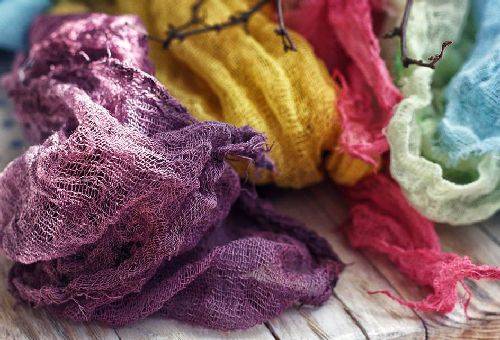
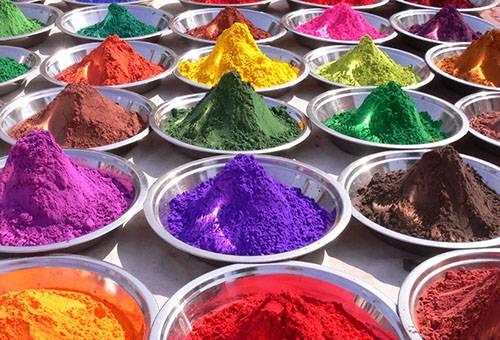
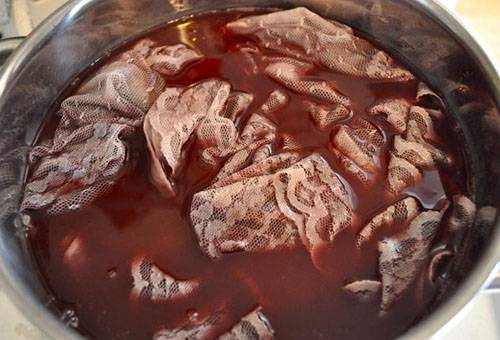
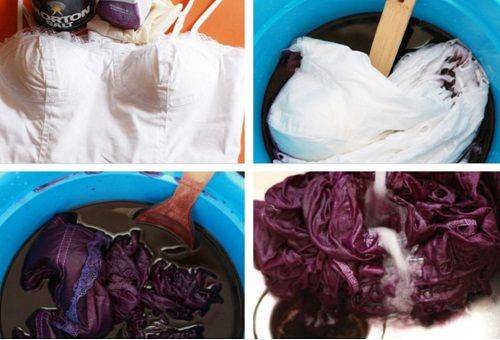
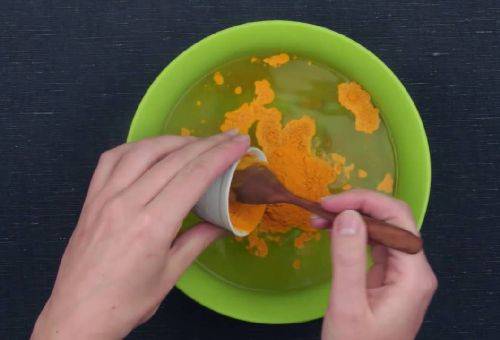
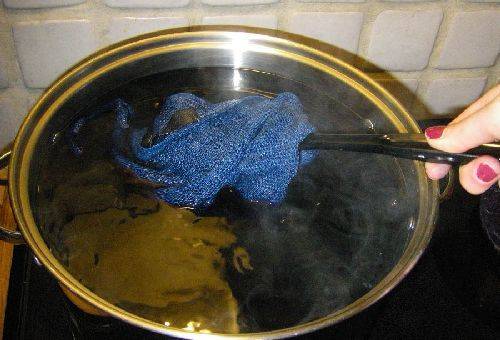
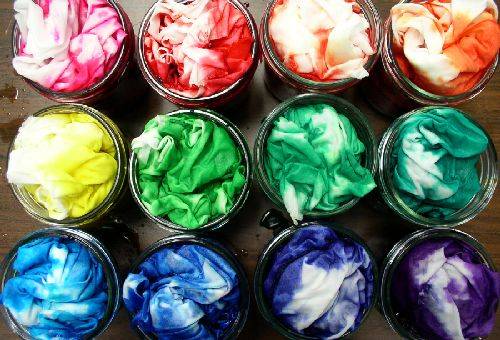
A very good article for novice housewives and not only...Thank you everyone for such instructive articles and advice...Nowadays, now every thing is registered...And if I used to be embarrassed by the poor, today I am glad that I can give a good thing a second life...Probably that's how it should be now..
How to dye blue shorts
My daughter dyed a white T-shirt with turmeric. I thought nothing would work out. Either the color will be pale or stained in spots... But it turned out well, the color is saturated, everything was painted evenly. Thanks to the author for the advice